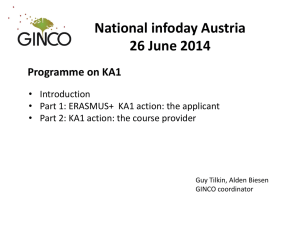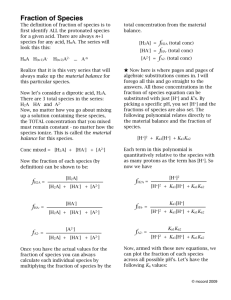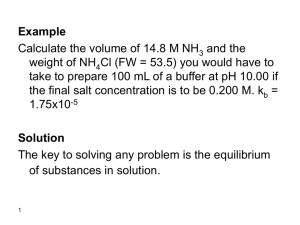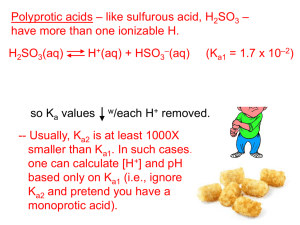GLOBAL SOLUTIONS TO SOME NONLINEAR DISSIPATIVE MILDLY DEGENERATE KIRCHHOFF EQUATIONS
advertisement
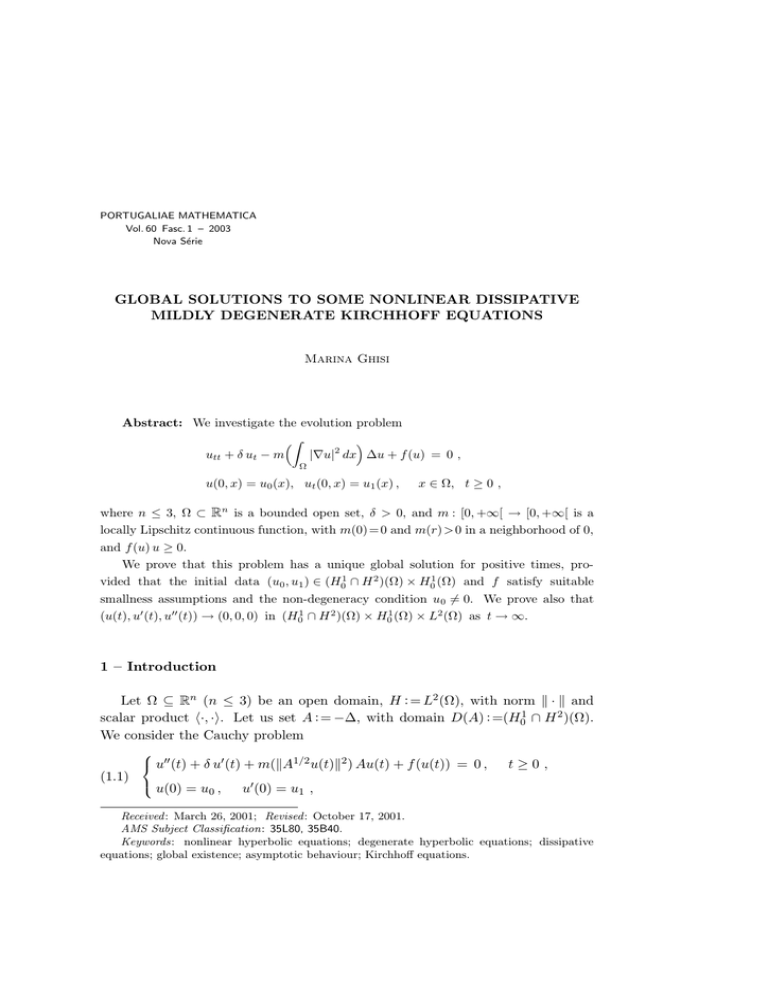
PORTUGALIAE MATHEMATICA
Vol. 60 Fasc. 1 – 2003
Nova Série
GLOBAL SOLUTIONS TO SOME NONLINEAR DISSIPATIVE
MILDLY DEGENERATE KIRCHHOFF EQUATIONS
Marina Ghisi
Abstract: We investigate the evolution problem
³Z
´
utt + δ ut − m
|∇u|2 dx ∆u + f (u) = 0 ,
Ω
u(0, x) = u0 (x), ut (0, x) = u1 (x) ,
x ∈ Ω, t ≥ 0 ,
where n ≤ 3, Ω ⊂ Rn is a bounded open set, δ > 0, and m : [0, +∞[ → [0, +∞[ is a
locally Lipschitz continuous function, with m(0) = 0 and m(r) > 0 in a neighborhood of 0,
and f (u) u ≥ 0.
We prove that this problem has a unique global solution for positive times, provided that the initial data (u0 , u1 ) ∈ (H01 ∩ H 2 )(Ω) × H01 (Ω) and f satisfy suitable
smallness assumptions and the non-degeneracy condition u0 6= 0. We prove also that
(u(t), u0 (t), u00 (t)) → (0, 0, 0) in (H01 ∩ H 2 )(Ω) × H01 (Ω) × L2 (Ω) as t → ∞.
1 – Introduction
Let Ω ⊆ Rn (n ≤ 3) be an open domain, H : = L2 (Ω), with norm k · k and
scalar product h·, ·i. Let us set A : = −∆, with domain D(A) : =(H01 ∩ H 2 )(Ω).
We consider the Cauchy problem
(1.1)
u00 (t) + δ u0 (t) + m(kA1/2 u(t)k2 ) Au(t) + f (u(t)) = 0 ,
u(0) = u ,
0
t≥0,
u0 (0) = u1 ,
Received : March 26, 2001; Revised : October 17, 2001.
AMS Subject Classification: 35L80, 35B40.
Keywords: nonlinear hyperbolic equations; degenerate hyperbolic equations; dissipative
equations; global existence; asymptotic behaviour; Kirchhoff equations.
2
MARINA GHISI
where δ > 0, m : [0, +∞[ → [0, +∞[ is a locally Lipschitz continuous function,
f ∈ C 1 (R) and f (u) u ≥ 0.
If Ω = [0, L] is an interval of the real line, this equation is a model for the
damped small transversal vibrations of an elastic string with fixed endpoints.
It is well known that the motion of a clamped string in the 3-dimensional
Euclidean space is described by a system of three quasilinear hyperbolic equations, whose unknowns are the transversal displacement u and the two components of the longitudinal displacement v. Unfortunately, the three equations in
the exact system cannot be uncoupled. However, in the monograph [7], Kirchhoff
showed that under the Ansatz that vtt = o(utt ), the string tension can be assumed
to be independent of x. Therefore it can be approximated by its x-average. This
allows to decouple the system (see [1] for the details), leading to the following
equation for the transversal motion u (that is the original form of (1.1)):
ρ h utt + δ ut + f =
Eh
m0 +
2L
µ
Z
L
0
|ux |
2
¶
uxx
where L is the rest-length, E is the Young modulus, ρ is the mass density, h is
the cross-section area, m0 is the initial axial tension, δ is the resistance modulus
and f is a nonlinear perturbation effect.
The Kirchhoff correction, where m(r) is a general stress-strain function, is less
drastic that the linear approximation, which correspond to consider the tension
independent of x and t.
The case m0 > 0 which in mathematics gives strict hyperbolicity, physically
correspond to a pre-stressed string. In this paper we are interested in strings
with zero rest-tension (m0 = 0), which mathematically corresponds to weak hyperbolicity. Moreover we do not limit ourselves to the case where the stress-strain
function m(r) has a polynomial decay at r = 0.
The case δ = 0, f = 0 (free vibrations) has long been studied: the interested
reader can find appropriate references in the surveys of A. Arosio [1] and
S. Spagnolo [13].
In the case δ = 0, f (u) = ±|u|α u with large α and m(r) ≥ ν > 0, P. D’Ancona
and S. Spagnolo [4] proved that if u0 , u1 ∈ C0∞ (Rn ) are small, then problem (1.1)
has a global solution.
The non-degenerate case (i.e. m(r) ≥ ν > 0) with δ > 0 and f = 0 was considered by E. H De Brito, Y. Yamada, and K. Nishihara [2, 12, 3, 9]: they proved
that for small initial data (u0 , u1 ) ∈ D(A) × D(A1/2 ) there exists a unique global
solution of (1.1) that decays exponentially as t → ∞.
GLOBAL SOLUTIONS TO SOME KIRCHHOFF EQUATIONS
3
Degenerate equations (m(r) ≥ 0) with δ > 0, f = 0, were considered by
K. Nishihara and Y. Yamada [10], for m(r) = r γ (γ ≥ 1), and for a general
m(r) ≥ 0 in [5]. In [5] it was proved the existence and uniqueness of a global
solution u(t) of (1.1) for small initial data (u0 , u1 ) ∈ D(A)×D(A1/2 ) with
m(kA1/2 u0 k2 ) 6= 0 and the asymptotic behaviour (u(t), u0 (t), u00 (t)) → (u∞ , 0, 0)
in D(A) × D(A1/2 ) × H as t → +∞, where either u∞ = 0 or m(kA1/2 u∞ k2 ) = 0.
The case m(r) ≥ ν > 0, δ > 0, f (u) = |u|α u has been considered by
M. Hosoya and S. Yamada [6] under the following condition:
0≤α<
2
n−4
if n ≥ 5 ,
0 ≤ α < +∞ if n ≤ 4 .
They proved that, if the initial data are small enough, problem (1.1) has a global
solution which decays exponentially as t → +∞.
Degenerate equations of type (1.1) were considered by K. Ono [11] when n ≤ 3,
for δ > 0, m(r) = r γ , f (u) ∼
= |u|α u. He proved that if the initial data are small
enough, u0 6= 0, and:
(1.2)
α > 2γ − 1
if n = 1, 2 ,
α > 4 γ − 2 if n = 3 ,
then problem (1.1) has a global solution, that decays with a polynomial rate as
t → +∞. However the technique of [11] which (besides the result of [10]) is based
on a decay Lemma by M. Nakao [8] does not seem to be extendible to more
general cases.
In this paper we consider problem (1.1) where m is any non-negative locally
Lipschitz continuous function, and m(0) = 0, m(r) > 0 in a neighborhood of 0.
We prove that there exists a unique global solution for (u0 , u1 ) ∈ D(A) × D(A1/2 )
provided that (u0 , u1 ) and f satisfy suitable smallness assumptions (cf. Theorem
2.2) and the non-degeneracy condition u0 6= 0 holds. Moreover we prove that
u(t) → 0 as t → ∞. (cf. Theorem 2.4).
NOTATIONS
In this paper, we denote by a1 , a2 , bε , a3 some constants such that
≤ a1 kA1/2 uk
u ∈ D(A1/2 )
n = 1, 2, 3 ;
kuk∞ ≤ a2 kA1/2 uk
u ∈ D(A1/2 )
n=1;
kuk∞ ≤ bε kAukε kA1/2 uk1−ε
u ∈ D(A)
n = 2, 0 < ε ≤ 1 ;
kuk∞ ≤ a3 kAuk1/2 kA1/2 uk1/2
u ∈ D(A)
n=3.
kuk
(1.3)
4
MARINA GHISI
2 – Statement of the results
In this section we state the main results of this paper. For completeness’ sake,
we recall the following local existence result, which may be proved by fixed point
theorems (a sketch of the proof is included in Section for the convenience of the
reader).
Theorem 2.1. (Local existence) Let δ > 0, let m : [0, +∞[ → [0, +∞[ be a
locally Lipschitz continuous function, f ∈ C 1 (R), and let (u0 , u1 ) ∈ D(A)×D(A1/2 )
with m(kA1/2 u0 k2 ) > 0.
Then there exists T > 0 such that problem (1.1) has a unique solution
u ∈ C 2 ([0, T ]; H) ∩ C 1 ([0, T ]; D(A1/2 )) ∩ C 0 ([0, T ]; D(A)) .
Moreover, u can be uniquely continued to a maximal solution defined in an
interval [0, T∗ [, and at least one of the following statements is valid:
(i) T∗ = ∞ ;
(ii) lim sup(kA1/2 u0 (t)k2 + kAu(t)k2 ) = +∞ ;
t→T∗−
(iii) lim inf m(kA1/2 u(t)k2 ) = 0 .
t→T∗−
We can state the global existence result.
Theorem 2.2. (Global existence) Let δ > 0, and let m(r) be a locally
Lipschitz continuous function with m(0) = 0 and m(r) > 0 on some ]0, r0 ].
Let us assume that f (y) is a C 1 function on R satisfying one of the following
conditions in some neighborhood of u = 0:
either
(i) f (y)y ≥ 0 and:
(2.1)
max |f 0 (y)| ≤
|y|≤s
or
(ii) f (0) = 0, f 0 ≥ 0 and:
(2.2)
0
max |f (y)| ≤
|y|≤s
for some ε > 0.
C m(s2+ε )
C m(s4 )
C m(s2+ε )s−1+ε
C m(s4 )s−2+ε
if n = 1, 2
if n = 3
if n = 1, 2
if n = 3
GLOBAL SOLUTIONS TO SOME KIRCHHOFF EQUATIONS
5
Moreover let us assume that the initial data (u0 , u1 ) ∈ D(A)×D(A1/2 ) are
small enough and satisfy the non-degeneracy condition u0 6= 0.
Then problem (1.1) admits a unique global solution
u ∈ C 2 ([0, +∞[; H) ∩ C 1 ([0, ∞[; D(A1/2 )) ∩ C 0 ([0, ∞[; D(A)) .
Remark 2.3. Theorem 2.2 (i) is still true, when n = 1, if we replace the
condition (2.1) with:
(2.3)
sup |f 0 (y)| ≤ C m(s2 ) ,
|y|≤a2 s
where a2 is a constant for which (1.3) holds.
If m(r) = r γ and |f 0 (u)| ≤ k |u|α , thanks to (2.3), by Theorem 2.2 (i), we
obtain the result of [11] under the stronger assumption that:
α ≥ 2 γ if n = 1 ,
α > 2 γ if n = 2 ,
α ≥ 4 γ if n = 3 .
On the other hand, Theorem 2.2 (ii) allows us to obtain the same conclusion
of [11] with m(r) = r γ , f (u) = |u|α u under the assumption (1.2).
Finally we have the following result.
Theorem 2.4. (Asymptotic behaviour) Under the assumptions of Theorem 2.2
we have that:
(i) m(kA1/2 u(t)k2 ) > 0 for all t ≥ 0;
(ii) (u(t), u0 (t), u00 (t)) → (0, 0, 0) in D(A)×D(A1/2 )×H as t → ∞.
The proof of Theorem 2.4 relies on a result about the asymptotic behaviour of
solutions of the linearization of (1.1) (see Lemma 3.2 for the precise statement).
3 – Proofs
3.1. Local existence
Proof of Theorem 2.1 (see [11]): Since the argument is standard, we only
sketch the main steps of the proof.
6
MARINA GHISI
Step 1. Let us set:
m0 : = m(kA
1/2
2
u0 k ) ,
2
m∗ : = max 1,
m0
½
F0 : = kA1/2 u1 k2 + m0 kAu0 k2 ,
cR : = km0 kL∞ ([0,a2 R2 ]) ,
1
fR : = max |f 0 (y)|,
|y|≤c1 R
Moreover let us define:
R2
,
m0
a1 a2
n = 1,
n = 2,
n=3.
b1
a √a
3
1
(
δ log 2
log 2
,
T : = min
αR 3 (fR + 2 cR R)2 a21 m∗
(3.1)
,
R 2 = 3 m ∗ F0 ,
αR : = 2 cR (a21 + 1)
where c1 : =
¾
)
.
Let us set C : = Cw0 ([0, T ]; D(A)) ∩ Cw1 ([0, T ]; D(A1/2 )) and let us consider the
functional space
XR,T : =
n
v ∈ C : v(0) = u0 , v 0 (0) = u1 ,
o
kA1/2 u0 (t)k2 + kAu(t)k2 ≤ R2 , t ∈ [0, T ] .
This space, with the distance:
³
d(v1 , v2 ) : = max k(v1 − v2 )0 (t)k2 + kA1/2 (v1 − v2 )(t)k2
t∈[0,T ]
is a complete metric space.
Let us set, for v ∈ XR,T :
cv (t) : = m(kA1/2 v(t)k2 ) .
Since
|c0v (t)| ≤ cR (a21 + 1) R2 <
it follows that
(3.2)
cv (t) >
m0
2
m0
2T
∀ t ∈ [0, T ] .
´1/2
GLOBAL SOLUTIONS TO SOME KIRCHHOFF EQUATIONS
7
We can therefore define
[Φ(v)] (t) = u ,
where u ∈ C is the unique solution of the linear problem
(3.3)
(
u00 (t) + δ u0 (t) + cv (t) Au(t) + f (v(t)) = 0 ,
u0 (0) = u1 .
u(0) = u0 ,
t≥0,
Step 2. We show that Φ maps XR,T into itself.
To this end, let us define:
F (t) : = kA1/2 u0 (t)k2 + cv (t) kAu(t)k2 .
By a standard computation, we obtain:
F 0 (t) ≤ αR F +
(fR a1 R)2
.
δ
Hence, recalling the definition of R, since
αR T ≤ log 2:
F ≤ F0 eαR T + (eαR T − 1)
ey −1
is an increasing function and
y
(fR a1 R)2
≤ 3 F0 .
δ αR
Thus we have proved that
kA1/2 u0 (t)k2 + kAu(t)k2 ≤ 3 m∗ F0 = R2 .
Step 3. We show that Φ is Lipschitz continuous, with a Lipschitz constant
less then 1. For v 1 , v 2 ∈ XR,T let us set u1 = Φ(v 1 ), u2 = Φ(v 2 ), w = u1 − u2 .
If we consider
Fw (t) : = kw0 (t)k2 + cv1 (t) kA1/2 w(t)k2 ,
then
Fw0 (t) ≤ αR Fw +
a21
(2 cR R + fR )2 d2 (v 1 , v 2 ) .
δ
Hence
d2 (u1 , u2 ) ≤ m∗ (eαR T − 1)
a21
1
(2 cR R + fR )2 d2 (v 1 , v 2 ) ≤ d2 (v 1 , v 2 ) .
δ αR
2
This complete the proof of this step.
8
MARINA GHISI
Step 4. By step 2 – step 3, the map Φ has a unique fixed point u that is a
weakly solution of (1.1); moreover in a standard way (see [14]) one can prove
that
u ∈ C 2 ([0, T ]; H) ∩ C 1 ([0, T ]; D(A1/2 )) ∩ C 0 ([0, T ]; D(A)) .
Step 5. Let us prove the last part of the statement.
Let [0, T∗ [ be the maximal interval where the solution exists, and let us assume by contradiction that (i), (ii), and (iii) are false. Then there exist two
constants ν, M such that m(kA1/2 u(t)k2 ) ≥ ν > 0 in a left neighborhood of T∗ ,
and kA1/2 u0 (t)k2 + kAu(t)k2 ≤ M for every t ∈ [0, T∗ [. By (3.1) it follows that,
for all S in a left neighborhood of T∗ , the life span of the solution of
w00 (t) + δ w 0 (t) + m(kA1/2 w(t)k2 ) Aw(t) + f (w(t)) = 0 ,
w(S) = u(S) ,
t≥S ,
w 0 (S) = u0 (S) ,
is larger then a strictly positive quantity independent of S. This contradicts the
maximality of T∗ .
3.2. Global existence
In the sequel we need the following comparison result for ODEs (the simple
proof is omitted).
Lemma 3.1. Let T > 0, and let g ∈ C 1 ([0, T [, R). Let us assume that
g(t) ≥ 0 in [0, T [ and that there exist two constants c1 > 0, c2 ≥ 0 such that
q
³ q
(g(t))0 ≤ − g(t) c1 g(t) − c2
Then
for all t ∈ [0, T [.
q
g(t) ≤ max
½q
´
∀ t ∈ [0, T [ .
c2
g(0),
c1
¾
From now on we use the following notations:
φε (n) : =
ε
−2/ε
(a1 a2 )
(bε )−2/ε
(a3 )
−4
n = 1,
n = 2,
n=3,
GLOBAL SOLUTIONS TO SOME KIRCHHOFF EQUATIONS
β :=
(
1
9
if n = 1, 2,
1/2
if n = 3 ,
√
µf (s) : = max |f 0 (y)| ,
c := C .
|y|≤s
With these notations, without loss of generality, we can rewrite (2.1)–(2.2) as
follows:
√
√
(3.4)
s ∈ [0, r0 ]
µf (sβ−ε ) ≤ c m(s2 )
for some 0 < ε < 1 if n = 1, 2, and ε = 0 if n = 3, and:
√
√
(3.5)
µf (sβ−ε0 ) ≤ c m(s2 ) sε1 −1 s ∈ [0, r0 ]
for some 0 < ε0 < 1 if n = 1, 2, ε0 = 0 if n = 3, and 0 < ε1 < 1.
Proof of Theorem 2.2:
Case (i)
Let us set:
E0 : = ku1 k2 +
F0 : =
Z
kA1/2 u0 k2
m(s) ds + 2
Z Z
u0
f (s) ds ,
Ω 0
0
kA1/2 u1 k2
c
δ
c
+ kAu0 k2 +
hu0 , u1 i + ku0 k2 + 2 E0
1/2
2
δ
2
2δ
m(kA u0 k )
µ
¶
(
p
2 √
ku1 k
, ( c a21 + 1) F0
G0 : = max
1/2
2
m(kA u0 k ) δ
cF 0 : =
max
0≤s≤a21 F0
)
|m0 (s)| .
Let us suppose that the initial data verifies:
cF 0 G 0
p
F0 <
δ
,
4
n
o
F0 < min φε , r0 a−2
=: σ .
1
We prove that under these smallness assumptions the solution u of (1.1) is a
global solution.
In the following let us set
c(t) = m(kA1/2 u(t)k2 ) .
Let us assume that m ∈ C 1 ([0, +∞[; R), and let [0, T∗ [ be the maximal interval
where the solution exists.
10
MARINA GHISI
Step 1. A priori estimates
Let us set
E(t) : = ku0 (t)k2 +
Z
kA1/2 u(t)k2
m(s) ds + 2
0
Z Z
u
f (s) ds + 2 δ
Ω 0
Z
t
0
ku0 (s)k2 ds .
Since E is a conserved energy and f (u)u ≥ 0, we have:
ku0 (t)k2 + 2 δ
(3.6)
Z
t
0
ku0 (s)k2 ds ≤ E(0) = E0
t ∈ [0, T∗ [ .
Furthermore, by taking the scalar product of the equation (1.1) with u, and
integrating on [0, t] we obtain:
Z t³
0
´
c(s) kA1/2 u(s)k2 + hf (u(s)), u(s)i ds =
t
=
Z
≤
Z
≤
1
δ
E0 + hu0 , u1 i + ku0 k2 .
2δ
2
0
t
0
ku0 (s)k2 ds + hu0 , u1 i − hu(t), u0 (t)i +
ku0 (s)k2 ds +
δ
δ
ku0 k2 − ku(t)k2
2
2
δ
ku0 (t)k2
+ hu0 , u1 i + ku0 k2
2δ
2
Hence, for t ∈ [0, T∗ [:
Z
(3.7)
t
0
c(s) kA1/2 u(s)k2 ds ≤
1
δ
E0 + hu0 , u1 i + ku0 k2 .
2δ
2
Step 2. Definitions – considerations
Let us set
(3.8)
¯ 0 ¯
¯ c (t) ¯ δ
¯ ≤ , kAu(t)k2 ≤ σ
T : = sup τ ∈ [0, T∗ [: c(t) > 0, ¯¯
c(t) ¯ 2
½
¾
∀ t ∈ [0, τ ] .
We show that T = T∗ . Let us assume by contradiction that T < T∗ . Since
¯ 0 ¯
¯c (t)¯ ≤ δ c(t) in [0, T [ we have that
2
(3.9)
0 < c(0) e−δT /2 ≤ c(T ) ≤ c(0) eδT /2 .
Moreover, by kAu(t)k2 ≤ σ we obtain:
kA1/2 u(t)k2 ≤ a21 kAu(t)k2 ≤ r0
t ∈ [0, T ] .
GLOBAL SOLUTIONS TO SOME KIRCHHOFF EQUATIONS
11
Since c(·), c0 (·), and kAu(·)k2 are continuous functions, by the maximality of T
we have that necessarily
¯ 0
¯
¯ c (T ) ¯
δ
¯
¯
(3.10)
¯ c(T ) ¯ = 2 ;
or
(3.11)
kAu(T )k2 = σ .
Step 3. (3.11) is false
Let us set
F (t) : =
kA1/2 u0 (t)k2
+ kAu(t)k2 .
c(t)
Then, a standard calculation shows that on [0, T [ we have:
µ
F 0 (t) ≤ − 2 δ +
≤ −
c0 (t)
c(t)
¶
2
kA1/2 u0 (t)k2
+
kA1/2 u0 (t)k kf 0 (u(t)) A1/2 u(t)k
c(t)
c(t)
δ kA1/2 u0 (t)k2
1
+
kf 0 (u(t)) A1/2 u(t)k2 .
2
c(t)
δc(t)
Since kAu(t)k2 ≤ φε , we have:
|u(t, x)| ≤ ku(t)k∞ ≤ kA1/2 u(t)kβ−ε ,
(3.12)
hence, by (3.4)
(3.13)
³
kf 0 (u(t)) A1/2 u(t)k2 ≤ µf kA1/2 u(t)kβ−ε
³
≤ c m kA1/2 u(t)k2
By this fact:
F (t) ≤ F (0) +
therefore, by (3.7)
(3.14)
c
δ
Z
t
0
´2
´2
kA1/2 u(t)k2
kA1/2 u(t)k2 .
c(s) kA1/2 u(s)k2 ds ;
F (T ) ≤ F0 < σ .
This contradicts (3.11).
Step 4. (3.10) is false
Let us define G(t) : =
ku0 (t)k
. By a simple computation, on [0, T [ we obtain:
c(t)
(G2 (t))0 ≤ −δ G2 (t) + 2 G(t) kAu(t)k + 2 G(t)
kf (u(t))k
.
c(t)
12
MARINA GHISI
Since f (0) = 0, by (3.4) (see (3.12)–(3.13)) we have:
Z
(3.15)
f (u(t, x))2 =
Ω
Z
f 0 (ξu (t, x))2 u2 (t, x)
Ω
³
≤ µf kA1/2 u(t)kβ−ε
³
´2
≤ c a41 m kA1/2 u(t)k2
ku(t)k2
´2
kAu(t)k2 .
By this fact, using the analogous of (3.14) for t ∈ [0, T [:
³
(G2 (t))0 ≤ − G(t) δ G(t) − 2 (1 +
Hence, applying Lemma 3.1 with g = G2 we have:
(
(3.16)
2 (1 +
G(T ) ≤ max G(0),
√ 2 p ´
c a 1 ) F0 .
)
√ 2
c a1 ) p
F0 = G 0 .
δ
By (3.14)–(3.16), we have then
¯
¯
¯
¯ 0
¯ 2 m0 (|A1/2 u(T )|2 ) hu0 (T ), Au(T )i ¯
¯ c (T ) ¯
¯
¯
¯
¯
¯
¯ c(T ) ¯ = ¯¯
¯
c(T )
≤ 2
max
0≤r≤a21 F0
≤ 2 c F 0 G0
p
|m0 (r)|
F0 <
|u0 (T )|
|Au(T )|
c(T )
δ
.
2
This contradicts (3.10).
Step 5. Conclusion
Let us assume by contradiction that T∗ < +∞. By (3.9) and (3.14) it follows
that
lim inf m(kA1/2 u(t)k2 ) ≥ m(kA1/2 u0 k2 ) e−δT∗ /2 > 0 ,
t→T∗−
n
o
lim sup kA1/2 u0 (t)k2 + kAu(t)k2 ≤ max 1, c(0) eδT∗ /2 F0 < +∞ .
t→T∗−
By the last statement of Theorem 2.1 this is a contradiction. This completes
the proof if m0 is continuous. If m is only locally Lipschitz continuous, thesis
follows from a standard approximation argument.
13
GLOBAL SOLUTIONS TO SOME KIRCHHOFF EQUATIONS
Case (ii)
Let us set:
E0 : =
ku1 k2
+ kA1/2 u0 k2 ,
m(kA1/2 u0 k2 )
H0 : =
hAu0 , u1 i
δ
,
kA1/2 u0 kε1 +
ε1
kA1/2 u0 k2−ε1
F (0) : =
kA1/2 u1 k2
+ kAu0 k2
m(kA1/2 u0 k2 )
c1 : = sup |m0 (s)| .
0≤s≤1
Moreover let us define:
n
o
σ : = min φε0 , r0 a−2
,
1
σ1 : = δ
1 − E(0)1−ε1 /2
,
c a21
σ2 : =
δ(σ − F (0))
.
c
Let us suppose that, for a suitable λ:
0 < λ < λ0 : = min{σ1 , σ2 } ,
a21
2 c1
H0 +
F0 < λ ,
δ
µ
¶
p
c 1 G0 F 0 <
δ
,
4
where
(
√
2 p
ku1 k
ε /2
1
, ( F0 + c a1+ε
G0 : = min
F0 1 )
1
1/2
2
m(kA u0 k ) δ
c a2
cλ
E(0)1−2/ε1 + 1 λ
F0 : = F (0) +
δ
δ
µ
ε1
2−ε1
¶
)
.
Then we prove that under these smallness conditions the solution u of (1.1) is a
global solution.
In the following let us set
c(t) = m(kA1/2 u(t)k2 ) .
Let us assume that m ∈ C 1 ([0, +∞[, R) and let [0, T∗ [ be the maximal interval
where the solution exists.
Step 1. Definitions – considerations
Let us set
(3.17)
(
¯ 0 ¯
¯ c (t) ¯
¯ ≤ δ , kAu(t)k2 ≤ σ
T : = sup τ ∈ [0, T∗ [ : c(t) > 0, ¯¯
c(t) ¯ 2
Z t
0
c(s) kA
1/2
ε1
u(s)k ds ≤ λ ∀ t ∈ [0, τ ]
)
.
14
MARINA GHISI
We show that T = T∗ . Let us assume by contradiction that T < T∗ .
Firstly let us remark that in [0, T ] we have:
kA1/2 u(t)k2 ≤ a21 kAu(t)k2 ≤ r0 .
¯
¯
δ
Furthermore, since ¯c0 (t)¯ ≤ c(t) in [0, T [, we have that
2
0 < c(0) e−δT /2 ≤ c(T ) ≤ c(0) eδT /2 .
(3.18)
Since c(t), c0 (t),
Z
t
0
c(s) kA1/2 u(s)kε1 ds and kAu(t)k2 are continuous functions,
by the maximality of T we have that necessarily
¯
¯ 0
¯ c (T ) ¯
δ
¯
¯
¯ c(T ) ¯ = 2 ;
(3.19)
or
(3.20)
kAu(T )k2 = σ ,
or
Z
(3.21)
T
0
c(s) kA1/2 u(s)kε1 ds = λ .
Step 2. (3.20) is false
Let us set:
ku0 (t)k2
+ kA1/2 u(t)k2 .
c(t)
E(t) : =
Hence a simple calculation show that in [0, T [ we have:
E 0 (t) ≤ −
δ ku0 (t)k2 kf (u(t))k2
+
;
2 c(t)
δ c(t)
therefore, as in (3.15), using (3.5), and kAu(t)k2 ≤ φε0 (see (3.12)):
E 0 (t) ≤
c a21
c a21
c(t) kA1/2 u(t)k2 ε1 ≤
c(t) kA1/2 u(t)kε1 E ε1 /2 .
δ
δ
By this fact, since λ ≤ λ0 we have:
(3.22)
E(t)1−ε1 /2 ≤ E(0)1−ε1 /2 +
c a21
λ =: γ ≤ 1 .
δ
We can now estimate
F (t) : =
kA1/2 u0 (t)k2
+ kAu(t)k2 .
c(t)
15
GLOBAL SOLUTIONS TO SOME KIRCHHOFF EQUATIONS
In fact, by using an estimate likes (3.13), we have:
F 0 (t) ≤ −
δ kA1/2 u0 (t)k2 c c(t)
+
kA1/2 u(t)kε1 E ε1 /2 (t) ,
2
c(t)
δ
hence:
(3.23)
δ
F (T )+
2
Z
0
T kA1/2 u0 (s)k2
c(s)
ds ≤ F (0)+
ε1
c λ 2−ε
cλ
γ 1 = F0 ≤ F (0)+
<σ .
δ
δ
Step 3. (3.21) is false
Au
By taking the scalar product of the equation (1.1) with
kA1/2 uk2−ε1
obtain:
µ
hu0 (t), Au(t)i
δ
+
kA1/2 u(t)kε1
1/2
2−ε
1
ε1
kA u(t)k
+
¶0
−
we
kA1/2 u0 (t)k2
c(t) kAu(t)k2
+
+
kA1/2 u(t)k2−ε1
kA1/2 u(t)k2−ε1
) hu0 (t), Au(t)i2
(2 − ε1
kA1/2 u(t)k4−ε1
+
D
f 0 (u(t)) A1/2 u(t), A1/2 u(t)
kA1/2 u(t)k2−ε1
E
= 0.
Hence integrating on [0, T [, since f 0 ≥ 0, using (3.22)–(3.23):
Z
hu0 (T ), Au(T )i
δ
kAu(t)k2
dt
≤
−
+
kA1/2 u(T )kε1
c(t)
1/2
1/2
2−ε
2−ε
1
1
ε1
kA u(t)k
kA u(T )k
T
0
µ
+ H0 +
Z
T
0
c(t)
kA1/2 u0 (t)k2
dt
1/2
c(t)
kA u(t)k2−ε1
ε1 kA1/2 u0 (T )k2
≤ H0 +
+ c1
2 δ kA1/2 u(t)k2−ε1
≤ H 0 + c1
≤ H0 +
Ã
kA1/2 u0 (T )k2
+
δ c(T )
Z
Z
0
T
kA1/2 u0 (t)k2
dt
c(t)
kA1/2 u0 (t)k2
dt
c(t)
T
0
2 c1
F0 .
δ
Therefore, by the smallness assumptions on the initial data:
Z
0
T
¶
µ
c(t) kA1/2 u(t)kε1 dt ≤ a21 H0 +
2 c1
F0
δ
¶
< λ.
!
16
MARINA GHISI
Step 4. (3.19) is false
Proceeding as in the proof of case (i), step 4, we can now estimate
ku0 (t)k
G(t): =
as follows:
c(t)
µ
(G2 (t))0 ≤ −δ G2 (t) + 2 G kAu(t)k +
³
≤ −G(t) δ G(t) − 2
p
F0 +
kf (u(t))k
c(t)
¶
√ 1+ε1 ε1 /2 ´
c a 1 F0
,
hence, applying Lemma 3.1, with g : = G2 we obtain G(t) ≤ G0 . Then as in the
proof of case (i), step 4:
Step 5. Conclusion
¯
¯ 0
p
¯ c (T ) ¯
δ
¯
¯
¯ c(T ) ¯ ≤ 2 c1 G0 F0 < 2 .
We can conclude as in step 5 of the proof of case (i).
Proof of Remark 2.3: It is enough to replace σ with r0 a−2
1 (taking ε = 0)
and to proceed as in the proof of Theorem (2.2) (i).
3.3. Asymptotic behaviour
In order to study the asymptotic behaviour of the solutions of (1.1), we consider the linearized problem
(
(3.24)
v 00 (t) + δ v 0 (t) + c(t) Av(t) + f (t, x) = 0 ,
v(0) = v0 ,
v 0 (0) = v1 .
t≥0,
In the following lemma we examine the asymptotic behaviour of the solutions
of (3.24).
Lemma 3.2. Let δ > 0. Let c : [0, +∞[ → ]0, +∞[ be a Lipschitz continuous
bounded function such that
¯ 0 ¯
¯ c (t) ¯
δ
¯
¯
for a.e. t ≥ 0 .
¯ c(t) ¯ ≤ 2
Let f : [0, +∞[ × Ω → R be a continuous function such that f (t, ·) ∈ D(A1/2 ) for
all t ≥ 0 and
Z
+∞
0
1
kA1/2 f (s)k2 ds < +∞ ,
c(s)
sup
t≥0
kf (t)k
< +∞ .
c(t)
GLOBAL SOLUTIONS TO SOME KIRCHHOFF EQUATIONS
17
Let v be the unique global solution of (3.24) with (v0 , v1 ) ∈ D(A)×D(A1/2 ).
Then there exists v∞ ∈ D(A) such that
(3.25)
v(t) −→ v∞
0
(3.26)
v (t) −→ 0
in D(A) ,
in D(A1/2 ) ,
as t → ∞. Furthermore, if v∞ 6= 0, then necessarily c(t) → 0 as t → ∞.
Proof of Lemma 3.2:
Step 1. Let us consider the function
H(t) : =
kA1/2 v 0 (t)k2
1
+ kAv(t)k2 −
c(t)
δ
Z
t
0
1
kA1/2 f (s)k2 ds .
c(s)
A simple computation shows that
H 0 (t) ≤ −
(3.27)
δ kA1/2 v 0 (t)k2
.
2
c(t)
By this fact we obtain:
1. for all t ≥ 0:
kA1/2 v 0 (t)k2
δ
+ kAv(t)k2 +
c(t)
2
≤
Z
0
t
kA1/2 v 0 (s)k2
ds ≤
c(s)
kA1/2 v1 k2
+ kAv0 k2 +
c(0)
Z
+∞
0
1
kA1/2 f (s, ·)k2 ds = : γ0 .
δ c(s)
2. Since the function c(·) is bounded then:
(3.28)
Z
+∞
0
kA1/2 v 0 (t)k2 dt < +∞
3. The function H is non-increasing, hence there exists:
kA1/2 v 0 (t)k2
+ kAv(t)k2 .
t→∞
c(t)
F∞ : = lim
If F∞ = 0, then (3.25) holds true with v∞ = 0. Since the function c is bounded,
then also (3.26) follows from F∞ = 0.
Therefore from now on we assume that F∞ > 0.
18
MARINA GHISI
Step 2. We show that
Z
(3.29)
∞
0
c(t) kAv(t)k2 dt < +∞ .
Indeed, taking the scalar product of the equation with Av and integrating on
[0, T ], it follows that
Z
T
δ
hA1/2 f (t), A1/2 u(t)i dt
kA1/2 v0 k2 −
2
0
Z T
δ
0
1/2
2
− hv (T ), Av(T )i − kA v(T )k +
kA1/2 v 0 (t)k2 dt
2
0
T
0
Z
c(t) kAv(t)k2 dt = hv1 , Av0 i +
≤ hv1 , Av0 i +
+ kck∞
+
1
2 a21
Z
Z
T
0
δ
1
kA1/2 v 0 (T )k2
kA1/2 v0 k2 +
kck∞
2
2δ
c(T )
kA1/2 v 0 (t)k2
dt
c(t)
T
0
c(t) kA1/2 u(t)k2 dt +
δ
≤ hv1 , Av0 i + kA1/2 v0 k2 +
2
Z
1 T
c(t) kAu(t)k2 dt .
+
2 0
µ
a21
2
Z
T
0
kA1/2 f (t)k2
dt
c(t)
2
δ a21
kck∞ +
γ0
δ
2
¶
Hence
Z
Ã
T
0
δ
c(t) kAv(t)k2 dt ≤ 2 hv1 , Av0 i + kA1/2 v0 k2 +
2
µ
δ a21
2
γ0
kck∞ +
δ
2
Passing to the limit as T → ∞, we obtain (3.29).
Step 3. From (3.28) and (3.29) it follows that
Z
∞
c(t)
0
µ
kA1/2 v 0 (t)k2
+ kAv(t)k2 dt < +∞ .
c(t)
¶
Since, for t ≥ T :
F∞
kA1/2 v 0 (t)k2
+ kAv(t)k2 ≥
> 0,
c(t)
2
then also
(3.30)
Z
∞
c(t) dt < +∞ .
0
¶
!
.
GLOBAL SOLUTIONS TO SOME KIRCHHOFF EQUATIONS
19
Since c(·) is Lipschitz continuous, it follows that c(t) → 0 as t → ∞. Since
≤ c(t) γ0 , then (3.26) is proved.
|A1/2 v 0 (t)|2
Step 4. We show that (3.25) holds true with the additional assumptions that
(v0 , v1 ) ∈ D(A2 )×D(A3/2 ), f (t, ·) ∈ D(A3/2 ) for every t and
Z
(3.31)
+∞
0
kA3/2 f (t)k
dt < +∞ ,
c(t)
sup
t≥0
kAf (t)k
< +∞ .
c(t)
To this end, let us introduce the function
Ĥ(t) : =
kA3/2 v 0 (t)k2
1
+ kA2 v(t)k2 −
c(t)
δ
Z
t
0
1
kA3/2 f (s)k2 ds .
c(s)
As in Step 1, it is possible to prove that Ĥ is non-increasing, and that for
every t ≥ 0:
kA2 v(t)k2 ≤ γ̂0 .
Now let us consider the function Ĝ(t) : =
kAv 0 (t)k
. We have that:
c(t)
(
2 0
(Ĝ(t) ) ≤ −Ĝ(t) δ Ĝ(t) − 2
µ
kAf (t)k
γ̂0 + sup
c(t)
t≥0
p
¶)
,
hence, by Lemma 3.1 with g = Ĝ2 , it follows that
(
)
µ
¶
2 p
kAf (t)k
Ĝ(t) ≤ max Ĝ(0),
.
γ̂0 + sup
δ
c(t)
t≥0
By (3.30), this implies that
Z
∞
0
kAv 0 (t)k dt < +∞
and therefore Av(t) has a limit as t → ∞.
Step 5. We show that (3.25) holds true for every initial data (v0 , v1 ) ∈
D(A)×D(A1/2 ).
To this end, let us consider a sequence {(v0n , v1n )} ⊆ D(A2 )×D(A3/2 ) converging to (v0 , v1 ) in D(A)×D(A1/2 ) and fn as in step 4, with:
Z
+∞
0
1
kA1/2 (f (t) − fn (t))k2 dt → 0
c(t)
as n → +∞ .
20
MARINA GHISI
Let {vn } be the corresponding solutions of (3.24), and let us set wn : = v − vn .
Since wn is a solution of (3.24), with f − fn in place of f , we have that
kA1/2 wn0 (t)k2
+ kAwn (t)k2 ≤
c(t)
Z
1 +∞ 1
kA1/2 (v1,n − v1 )k2
+ kA(v0,n − v0 )k2 +
kA1/2 (f (t) − fn (t))k2 dt .
≤
c(0)
δ 0 c(t)
This proves that {Avn } → Av uniformly in [0, +∞[. Since Avn (t) has a limit as
t → ∞ for every n ∈ N (see Step 4), then necessarily Av(t) has a limit as t → ∞.
This completes the proof of (3.25).
Proof of Theorem 2.4: We use the same notations as in the proof of
Theorem 2.2 case (i) (resp. case (ii)). Let us first remark that u is the solution
of (3.24) with
c(t) = m(kA1/2 u(t)k2 ) ,
(v0 , v1 ) = (u0 , u1 ) ,
f (t, x) = f (u(t, x)) .
In Step 2 of the proof of Theorem 2.2 case (i) (resp. Step 1 of case (ii)), we
showed that c(t) > 0 for every t ≥ 0 (this proves statement (i)), and
¯ 0 ¯
¯ c (t) ¯
δ
¯
¯
¯ c(t) ¯ ≤ 2
∀t≥0 .
Moreover in this step we proved also that kA1/2 uk ≤ r0 , hence c(·) is bounded.
Since m is locally Lipschitz continuous, and kA1/2 u0 (t)k2 ≤ F (t) c(t) ≤ F0 c(t)
(see (3.14) (resp. (3.23))), then it turns out that c(·) is globally Lipschitz continuous. Finally, as in (3.13), (3.15), by step 1 (resp. step 1):
Z
+∞
0
kA1/2 f (u(t))k2
dt ≤ c
c(t)
Z
+∞
c(t) kA1/2 u(t)k2 < +∞ ,
0
kf (u(t))k2
c a21 c2 (t) kA1/2 u(t)k2
≤
< c0
c2 (t)
c2 (t)
³
resp.
Z
+∞
0
kA1/2 f (u(t))k2
dt ≤ c
c(t)
Z
0
+∞
c(t) kA1/2 u(t)k2ε1 < +∞ ,
´
kf (u(t))k2
2
1/2
2ε1
≤
c
a
kA
u(t)k
<
c
0
1
c2 (t)
for some c0 independent on t.
GLOBAL SOLUTIONS TO SOME KIRCHHOFF EQUATIONS
21
By Lemma 3.2, there exists u∞ ∈ D(A) such that u → u∞ in D(A) and u0 → 0
in D(A1/2 ). Let us assume that u∞ 6= 0, then by the last statement of Lemma 3.2
we have that c(t) → 0 as t → ∞, hence
0 = lim m(kA1/2 u(t)k2 ) = m(kA1/2 u∞ k2 ) .
t→∞
Since kA1/2 u∞ k2 ≤ r0 , it follows that u∞ = 0. Furthermore, using the equation
(1.1), u00 → 0 in H.
ACKNOWLEDGEMENT – The author wish to thank S. Spagnolo for the interesting
discussions about the argument.
REFERENCES
[1] Arosio, A. – Averaged evolution equations. The Kirchhoff string and its treatment in scales of Banach spaces, Proceedings of the “2nd Workshop on Functional–
Analytic Methods in Complex Analysis” (Trieste, 1993), World Scientific, Singapore.
[2] Brito, E.H. de – The damped elastic stretched string equation generalized: existence, uniqueness, regularity and stability, Applicable Analysis, 13 (1982), 219–233.
[3] Brito, E.H. de – Decay estimates for the generalized damped extensible string
and beam equation, Nonlinear Analysis, 8 (1984), 1489–1496.
[4] D’Ancona, P. and Spagnolo, S. – Nonlinear perturbations of the Kirchhoff
equation, Comm. Pure Appl. Math., 47 (1994), 1005–1029.
[5] Ghisi, M. and Gobbino, M. – Global Existence for a Mildly Degenerate Dissipative Hyperbolic Equation of Kirchhoff Type, Preprint Dip. Mat. Univ. Pisa (1997).
[6] Hosoya, M. and Yamada, Y. – On some nonlinear wave equations II: global
existence and energy decay of solutions, J. Fac. Sci. Univ. Tokyo, Sect. IA Math.,
38 (1991), 239–250.
[7] Kirchhoff, G. – Vorbesuregen uber Mechanik, Teubner, Leipzig, 1883.
[8] Nakao, M. – A Difference Inequality and its Application to Nonlinear Evolution
Equations, J. Math. Soc. Japan, 30 (1978), 747–762.
[9] Nishihara, K. – Global existence and asymptotic behaviour of the solution of
some quasilinear hyperbolic equation with linear damping, Funkcial. Ekvac., 32
(1989), 343–355.
[10] Nishihara, K. and Yamada, Y. – On global solutions of some degenerate quasilinear hyperbolic equations with dissipative terms, Funkcial. Ekvac., 33 (1990),
151–159.
[11] Ono, K. – Global existence and decay properties of solutions of some mildly
degenerate nonlinear dissipative Kirchhoff strings, Funkcial. Ekvac., 40 (1997), 255–
270.
22
MARINA GHISI
[12] Yamada, Y. – On some quasilinear wave equations with dissipative terms, Nagoya
Math. J., 87 (1982), 17–39.
[13] Spagnolo, S. – The Cauchy problem for the Kirchhoff equation, Rend. Sem. Fis.
Matem. di Milano, 62 (1992), 17–51.
[14] Temam, R. – Infinite – Dimensional Dynamical Systems in Mechanics and Physics,
Applied Mathematical Sciences, 68, Springer-Verlag, New York 1988.
Marina Ghisi,
Università degli Studi di Pisa, Dipartimento di Matematica,
via M. Buonarroti 2, 56127 Pisa – ITALY
E-mail: ghisi@dm.unipi.it

